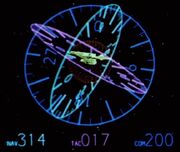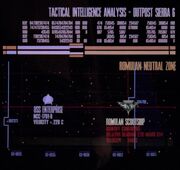Lakenheath72 (talk | contribs) mNo edit summary Tag: sourceedit |
m (Robot: Automated text replacement (-(pg. +(p. )) Tag: apiedit |
||
| (4 intermediate revisions by 3 users not shown) | |||
| Line 4: | Line 4: | ||
== Uses == |
== Uses == |
||
| + | {{pna-incomplete}} |
||
Bearings were commonly used to define the direction at which another object or the origin of a transmission was located in [[space]], in relation to the current orientation of the ship. Bearings have also been used to indicate a direction on a [[planet]] by an [[away team]] on the surface or from the planet's [[atmosphere]]. Bearings were also used when the ship made a course correction in its current [[heading]]. ({{TOS|Balance of Terror|By Any Other Name}}; {{film|4}}) |
Bearings were commonly used to define the direction at which another object or the origin of a transmission was located in [[space]], in relation to the current orientation of the ship. Bearings have also been used to indicate a direction on a [[planet]] by an [[away team]] on the surface or from the planet's [[atmosphere]]. Bearings were also used when the ship made a course correction in its current [[heading]]. ({{TOS|Balance of Terror|By Any Other Name}}; {{film|4}}) |
||
| + | |||
| + | The [[Picard Maneuver]] included a [[sensor]] bearing. ({{TNG|The Battle}}) |
||
In space, bearings were given in one or two 360-degree angles, sometimes with one or two decimal place accuracy, with various other information. For example: |
In space, bearings were given in one or two 360-degree angles, sometimes with one or two decimal place accuracy, with various other information. For example: |
||
| Line 10: | Line 13: | ||
* "''0-mark-4.''" ({{VOY|Once Upon a Time}}) |
* "''0-mark-4.''" ({{VOY|Once Upon a Time}}) |
||
* "''111-mark-14''" ({{TOS|Balance of Terror}}) |
* "''111-mark-14''" ({{TOS|Balance of Terror}}) |
||
| + | * "''235-point-7''" ({{TNG|Haven}}) |
||
* "''316-mark-4''" ({{film|2}}) |
* "''316-mark-4''" ({{film|2}}) |
||
* "''Mark-73-point-5.''" ({{TOS|Elaan of Troyius}}) |
* "''Mark-73-point-5.''" ({{TOS|Elaan of Troyius}}) |
||
| Line 17: | Line 21: | ||
* "''240 degrees-mark-6, [[port]].''" ({{film|6}}) |
* "''240 degrees-mark-6, [[port]].''" ({{film|6}}) |
||
* "''123 degrees-mark-18. Range 90 thousand kilometers.''" ({{TOS|The Changeling}}) |
* "''123 degrees-mark-18. Range 90 thousand kilometers.''" ({{TOS|The Changeling}}) |
||
| + | * 004-mark-009 ([[DS9]]: "[[Sacrifice of Angels]]") |
||
On a planet, bearings were also given in one or two 360-degree angles, with various other information. For example: |
On a planet, bearings were also given in one or two 360-degree angles, with various other information. For example: |
||
| Line 35: | Line 40: | ||
=== Background information === |
=== Background information === |
||
| − | The first use of the term bearing to indicate a direction occurred in ''[[Star Trek: The Original Series]]'' episode "Balance of Terror". The meaning of bearings has been further defined in the writer's guides and several [[reference books]], such as ''[[Star Trek: The Next Generation Technical Manual]]'' ( |
+ | The first use of the term bearing to indicate a direction occurred in ''[[Star Trek: The Original Series]]'' episode "Balance of Terror". The meaning of bearings has been further defined in the writer's guides and several [[reference books]], such as ''[[Star Trek: The Next Generation Technical Manual]]'' (p. 36). Bearing 000-mark-0 is directly in front of the ship and bearing 180-mark-0 directly behind the ship. Coming about to bearing 090-mark-0 would be a sharp turn to the right or [[starboard]]. Coming about to bearing 270-mark-0 would be a sharp turn to the left or port. The second figure after the "mark" is the elevation angle. Coming about to bearing 000-mark-90 would be tilting the ship directly upwards and 000-mark-270 directly downwards. |
=== Deleted references === |
=== Deleted references === |
||
| − | According to the {{st-minutiae| |
+ | According to the {{st-minutiae|resources/scripts/twok.txt|script}} for {{film|2}}, a second patrol formation of [[Klingon]] [[cruiser]]s approached the {{USS|Enterprise|NCC-1701}} on a bearing of "''090-mark-20''" to the {{USS|Enterprise|NCC-1701}} in the ''[[Kobayashi Maru]]'' [[Kobayashi Maru scenario|scenario]]. |
| − | According to the {{st-minutiae| |
+ | According to the {{st-minutiae|resources/scripts/tvh.txt|script}} for {{film|4}}, as the {{HMS|Bounty}} was leaving [[Earth]], [[Nyota Uhura|Uhura]] detected an unidentified [[aircraft]] in Earth's [[atmosphere]] at "''range 30 miles, bearing 010''". |
=== External link === |
=== External link === |
||
Revision as of 02:08, 5 March 2016

360-degree axes

Romulan scoutship at relative bearing 270/mark 014
A bearing, sometimes referred to as relative bearing, was a common way to describe a specific direction in relation to a starship. (TOS: "Balance of Terror"; TNG: "The Defector" display graphic)
Uses
Bearings were commonly used to define the direction at which another object or the origin of a transmission was located in space, in relation to the current orientation of the ship. Bearings have also been used to indicate a direction on a planet by an away team on the surface or from the planet's atmosphere. Bearings were also used when the ship made a course correction in its current heading. (TOS: "Balance of Terror", "By Any Other Name"; Star Trek IV: The Voyage Home)
The Picard Maneuver included a sensor bearing. (TNG: "The Battle")
In space, bearings were given in one or two 360-degree angles, sometimes with one or two decimal place accuracy, with various other information. For example:
- "05-mark-231." (TNG: "The Emissary")
- "0-mark-4." (VOY: "Once Upon a Time")
- "111-mark-14" (TOS: "Balance of Terror")
- "235-point-7" (TNG: "Haven")
- "316-mark-4" (Star Trek II: The Wrath of Khan)
- "Mark-73-point-5." (TOS: "Elaan of Troyius")
- "23-mark-217. Range 31 hundred kilometers." (DS9: "Emissary")
- "001-mark-point-03. Range 300 thousand kilometers." (TNG: "Sins of the Father")
- "320 degrees-mark-2." (Star Trek)
- "240 degrees-mark-6, port." (Star Trek VI: The Undiscovered Country)
- "123 degrees-mark-18. Range 90 thousand kilometers." (TOS: "The Changeling")
- 004-mark-009 (DS9: "Sacrifice of Angels")
On a planet, bearings were also given in one or two 360-degree angles, with various other information. For example:
- "300-mark-7." (TOS: "By Any Other Name")
- "94-mark-7, angle of elevation 6 degrees." (TOS: "Obsession")
- "About 11 miles, bearing 121 from the mining company." (TOS: "Mudd's Women")
- "283 degrees. 15.2 kilometers." (Star Trek IV: The Voyage Home)
- "327 degrees. Distance 600 nautical." (Star Trek IV: The Voyage Home)
Appendices
See also
Background information
The first use of the term bearing to indicate a direction occurred in Star Trek: The Original Series episode "Balance of Terror". The meaning of bearings has been further defined in the writer's guides and several reference books, such as Star Trek: The Next Generation Technical Manual (p. 36). Bearing 000-mark-0 is directly in front of the ship and bearing 180-mark-0 directly behind the ship. Coming about to bearing 090-mark-0 would be a sharp turn to the right or starboard. Coming about to bearing 270-mark-0 would be a sharp turn to the left or port. The second figure after the "mark" is the elevation angle. Coming about to bearing 000-mark-90 would be tilting the ship directly upwards and 000-mark-270 directly downwards.
Deleted references
According to the script for Star Trek II: The Wrath of Khan, a second patrol formation of Klingon cruisers approached the USS Enterprise on a bearing of "090-mark-20" to the USS Enterprise in the Kobayashi Maru scenario.
According to the script for Star Trek IV: The Voyage Home, as the HMS Bounty was leaving Earth, Uhura detected an unidentified aircraft in Earth's atmosphere at "range 30 miles, bearing 010".
